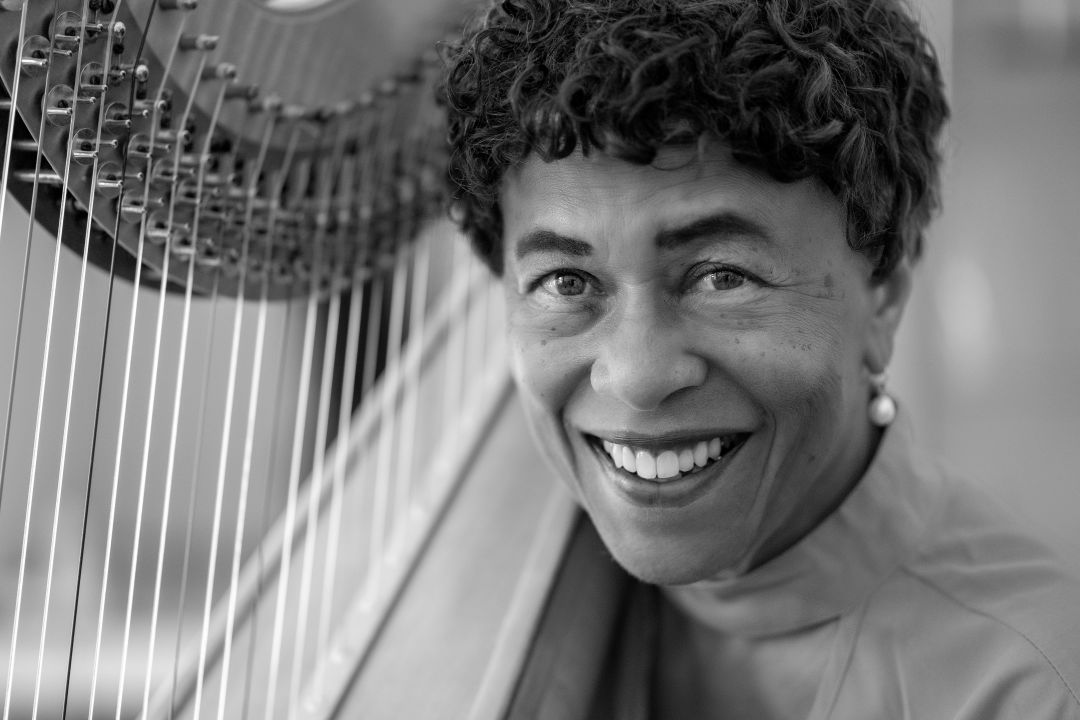Harpist Ann Hobson Pilot on Overcoming Racism in Classical Music
This article is part of the series In Their Own Words, proudly presented by Gulf Coast Community Foundation.

Ann Hobson Pilot
Image: Michael Kinsey
Ann Hobson Pilot is a classical music legend. A veteran harpist, she was the first Black female principal player in a major symphony orchestra. She also boasts an extensive international solo career, with eight albums to her name.
Pilot holds three honorary doctorates, as well as the Gold Baton from the League of American Orchestras, which puts her in the company of greats like Leonard Bernstein, Aaron Copland and Yo-Yo Ma. She is the only harpist on the list.
She has taught at the New England Conservatory of Music, Boston University, State College of Florida, Tanglewood Music Center and the Boston University Tanglewood Institute. She also mentors musicians of color and those in underserved communities. In 2011, she was the subject of a documentary, A Harpist’s Legacy: Ann Hobson Pilot and the Sound of Change, which aired on PBS stations nationwide. And in 2016, she played at the opening of the National Museum of African American History and Culture in Washington, D.C.
Now 76 years old and retired, Pilot lives in Osprey with her husband, Prentice.
You attended grade and high schools during a tumultuous time. By your senior year, you were considered a concert-caliber artist. What was it like growing up in Philadelphia as a young girl with spectacular talent?
“My father was in the Army, so my family lived in Germany until 1952, when I was between the ages of 5 and 9. I attended Army schools. It was very different there than in the United States—not as much race consciousness.
I first studied piano as a child because my mother was a concert pianist. It wasn’t until I was 14 that I took up the harp while I attended the Philadelphia High School for Girls, the same school my mother and older sister attended. There were just a few Blacks in school. The white kids couldn’t seem to grasp the idea of a Black girl playing the harp. I would hear, ‘Only angels play the harp, who ever heard of a Black angel?’
However, it wasn’t only the children who doubted my ability. One afternoon, I went over to the home of a white friend who played the harp as well. When she left the room, her mother pointed to a portrait on the wall of a white woman, with long blond hair, playing the harp, and she said, ‘See, she is what a harpist is supposed to look like.’ I was shocked that she said that to me. What did she want me to do, quit?”
What was your first foray into playing professionally?
“I began with concerts at school and church. When I graduated, I attended the Philadelphia Musical Academy, where a violin instructor recommended me for a couple gigs at the Latin Casino, a Philadelphia-area nightclub. I was 18, and I played with three acts there that requested the harp: Peggy Lee, Andy Williams, and Johnny Mathis. I will always remember how, when Mathis would sing ‘Chances Are,’ he brought the mic over and sang to me on bended knee. I had to concentrate on my playing! Then, he would turn to the audience and say, ‘And she’s only 18, folks.’”
You attended the Cleveland Institute of Music. What was your first experience there like?
“In 2018, I gave the commencement speech at the institute. While preparing my remarks, I recalled something I had long forgotten. I don’t think I ever even shared it with my parents.
"My parents drove me up to the Case Western [Reserve University] dorms, where a lot of the Cleveland Institute of Music students stay. The dorm mother showed me to my room, where I met my roommate and unpacked. Then my parents took me to dinner. By the time I returned, my roommate had moved out. She told the room mother she would not room with a Black person.”
In 1962, famed harpist Alice Chalifoux took you under her wing. What was the experience like as her only Black student?
“There’s no doubt in my mind that Miss Chalifoux had reservations about me; she was born and raised in Birmingham, Alabama. Sometimes during a lesson, when she thought I was playing especially well, she would say, ‘Annie’— she called me Annie — ‘when you were playing just now, I forgot that you were Black for a minute.’
Now, we could go into a whole dialogue about what that means. For instance, when you listen to music, do you see color? But I accepted her ways because she was the best instructor. She recognized my talent, she was in my corner, and I wanted to be the best harpist I could become.
Our relationship was very congenial, and we were friends until her death. She lived more than 100 years. She was so much a part of my life that her daughter, Alyce, and I are still connected.”
In 1966, you became the first Black musician at the Washington National Symphony, not long after the Philadelphia race riots in your hometown. What was it like to enter the exclusively white world of classical music at that time?
“Fortunately, I had plenty of experience with this, because just about every school I attended was predominantly white, even camp—the harp world was all white. Still, this didn’t freak me out. Playing the harp was what I wanted to do, and I thought the prejudice was more other people’s problems than mine.”
Where did you find this strength?
“Definitely from my mother. She was a strong woman who lived in the white world of classical music herself. My mother wanted us to know that we were not less than others, but also that we certainly should not think that we were better.”
In 1969, you made history when you accepted a position with the Boston Symphony Orchestra, the first Black female member. You spent the next four decades there—29 years as principal harpist—until your retirement in 2009. What was your first day like?
“I arrived early to tune the harp and warm up. I remember how impressed I was with the beautiful hall and its acoustics. I thought, ‘Wow, this is fantastic.’
Not long after, an elderly man—a longtime member who thought he owned the place—came charging up to the stage. I expected him to say something like, ‘Welcome to the orchestra.’ Was I wrong!
What he said was, ‘You must fry some mean chicken.’ In disbelief, I said, ‘Excuse me?’ So he repeated it. By the third time, I responded with, ‘As a matter of fact, I do.’ I worked with him for about 20 years, and whenever he spoke to me, it had to do with race.”
Did the orchestra come to accept the color of your skin?
“Most were polite, but I did have to stand up for myself. There was one incident when a [male] orchestra member, a percussionist, was in the hallway, surrounded by women, holding court. Black composer Olly Wilson and I had finished our performance and were leaving. I had my coat on when the orchestra member said, ‘Why do all the [n-words] leave early?’
The women gasped, while I turned to glare at him. The next day, I forcefully told him, ‘Don’t you ever use that word in front of me again.’ To his credit, he did not. If he did, I would have reported his behavior. Those are the kind of experiences that only Black members of the orchestra had to deal with.”
Has the classical music world seen a shift in attitudes toward musicians of color?
“As musicians of color have entered the classic music field— some with great success —there has been a shift in attitude. In the late 1960s, I was the only one. However, the major orchestras haven’t changed that much in terms of numbers of Black members— there’s only one in New York, one in Cleveland and one in Boston. You’d think that, by now, that the orchestras would be more representative of the population.
"Now, it is difficult to get those jobs. Auditions are held with musicians behind a screen, so the decision-makers are not prejudiced. There’s a debate going on now, led by the League of American Orchestras, about whether it’s time to lift the screen to create diversity in symphonies.
"The screen was instituted the year before I auditioned for Boston Symphony Orchestra in 1969. It did work from the standpoint of sex. When I auditioned, there were only four women in the orchestra, now there are more than 40.
"However, for more than 50 years, it has not resulted in more people of color becoming symphony members. So, regarding race, there is value to the argument for taking the screen down, even though one would think it would help. We could forever discuss why that is the case. One of my theories is that behind a screen you can only hear the instrument, so what if one competing player has a half-million dollar violin vs. a $10,000 fiddle? Who has the upper hand? It could be a signal that it’s an economic issue—a child from the projects could be gifted musically but they cannot compete with a child of means. It’s a difficult situation that orchestras have tried to remedy with the screen, but it has not done what they wanted to accomplish.
"Today, though, more all-Black chamber music groups exist. I play with the Ritz Chamber Players, a really talented group of musicians. And the Sphinx Organization in Detroit is building diversity in classical music, bringing up musicians of color.”
Looking back over your career, what are you most proud of?
“At the top of the list is a retirement gift of the harp and orchestra concerto “On Willows and Birches” from composer John Williams of Star Wars fame. It was my greatest honor to have this harp piece added to the BSO orchestra’s harp repertoire in my name.”
If you could implore your white friend/neighbor/colleague/community to do one thing right now, what would it be?
“Vote. And support musicians and artists who are clearly hurting during the pandemic.”
Listening to Black Voices is a series created by Heather Dunhill




